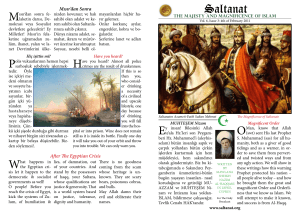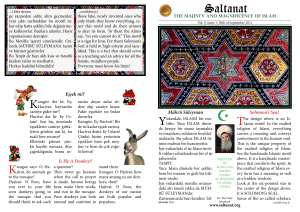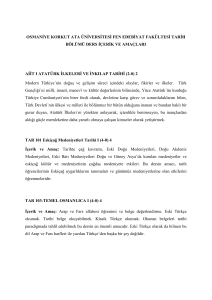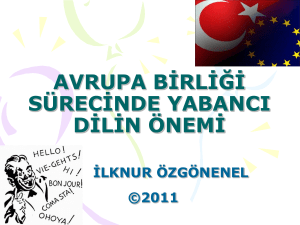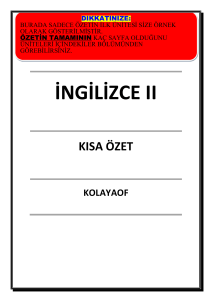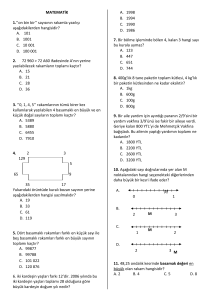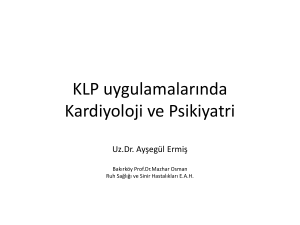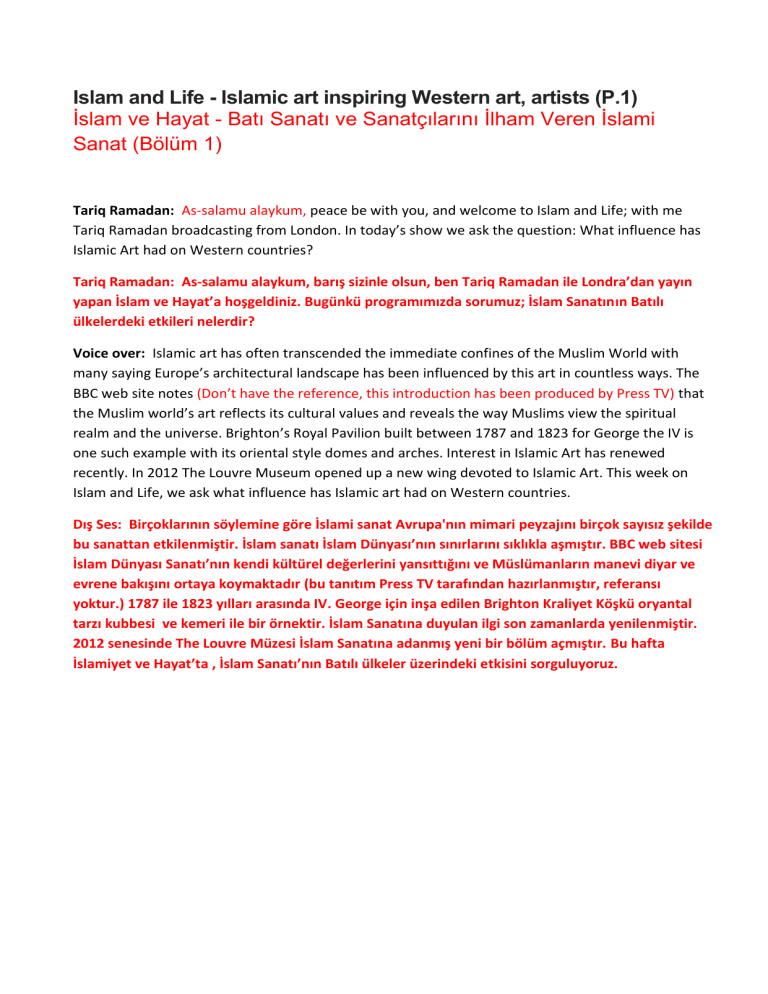
Islam and Life - Islamic art inspiring Western art, artists (P.1)
İslam ve Hayat - Batı Sanatı ve Sanatçılarını İlham Veren İslami
Sanat (Bölüm 1)
Tariq Ramadan: As-salamu alaykum, peace be with you, and welcome to Islam and Life; with me
Tariq Ramadan broadcasting from London. In today’s show we ask the question: What influence has
Islamic Art had on Western countries?
Tariq Ramadan: As-salamu alaykum, barış sizinle olsun, ben Tariq Ramadan ile Londra’dan yayın
yapan İslam ve Hayat’a hoşgeldiniz. Bugünkü programımızda sorumuz; İslam Sanatının Batılı
ülkelerdeki etkileri nelerdir?
Voice over: Islamic art has often transcended the immediate confines of the Muslim World with
many saying Europe’s architectural landscape has been influenced by this art in countless ways. The
BBC web site notes (Don’t have the reference, this introduction has been produced by Press TV) that
the Muslim world’s art reflects its cultural values and reveals the way Muslims view the spiritual
realm and the universe. Brighton’s Royal Pavilion built between 1787 and 1823 for George the IV is
one such example with its oriental style domes and arches. Interest in Islamic Art has renewed
recently. In 2012 The Louvre Museum opened up a new wing devoted to Islamic Art. This week on
Islam and Life, we ask what influence has Islamic art had on Western countries.
Dış Ses: Birçoklarının söylemine göre İslami sanat Avrupa'nın mimari peyzajını birçok sayısız şekilde
bu sanattan etkilenmiştir. İslam sanatı İslam Dünyası’nın sınırlarını sıklıkla aşmıştır. BBC web sitesi
İslam Dünyası Sanatı’nın kendi kültürel değerlerini yansıttığını ve Müslümanların manevi diyar ve
evrene bakışını ortaya koymaktadır (bu tanıtım Press TV tarafından hazırlanmıştır, referansı
yoktur.) 1787 ile 1823 yılları arasında IV. George için inşa edilen Brighton Kraliyet Köşkü oryantal
tarzı kubbesi ve kemeri ile bir örnektir. İslam Sanatına duyulan ilgi son zamanlarda yenilenmiştir.
2012 senesinde The Louvre Müzesi İslam Sanatına adanmış yeni bir bölüm açmıştır. Bu hafta
İslamiyet ve Hayat’ta , İslam Sanatı’nın Batılı ülkeler üzerindeki etkisini sorguluyoruz.
Tariq Ramadan: Art is not only about entertainment, it is deeper than that; it has to do with a
concept of life even a concept of death. It has to do with imagination, it has to do with culture, it has
to do with the universality of the Islamic message from the oneness of God to the oneness of
humanity and the diversity of cultures and when we come back to the History of Islam and Islamic Art
or arts in Islam as some artists are putting it. We can see here many influences in something which is
deep as to the relationship between art and universe, art and human beings, art and co-existence and
even art and poetry and the way people are expressing themselves as we find in the Qur’an.
“Allamahu-l-bayan” (He taught him speech, Qur’an 55:4), meaning that God taught human beings
expression the way they can understand the Qur’an, but the way also they are expressing
themselves. So there is something which is very deep here when it comes to art and we have to try to
understand what is the very essence of art in Islam and then in which way the past was full of this
imagination and why today we have the feeling that it is less; the Muslim majority countries and the
Muslims are less creative and in which way this art has influenced the West and could also contribute
to the future of the world, the future of the western countries to put it in a simple way. These are
essential questions and to answer all these questions, I am joined by my guest, Dr Sahib Mustaqim
Bleher; imam and author. Thank you so much for being with us today. Let me start with this first
question - Because many people are saying is there something that we can call Islamic Art? Or do we
have to call Art in Islam as Islam civilisation and also a religion. How would you put it because we are
talking about Islamic Art and how would you define Islamic Art?
Tariq Ramadan: Sanat sadece eğlence değildir, bundan daha derindir; hayat kavramı ile hatta ölüm
kavramı ile bile ilgilidir. İslam Tarihine ve İslam sanat veya İslamda sanata geldiğimizde, bazı
sanatçıların bahsettiği gibi sanatın hayal gücü ile kültür ile İslami mesajın evrenselliği ile Allah'ın
birliğinden insanlığın birliğine ve kültürlerin çeşitliliği ile ilgilidir. Burada sanat ve evren, sanat ve
insan, sanat ve bir arada yaşama ve hatta sanat ve şiir ve insanların kendilerini ifade ediş biçimleri
Kuran'da bulduğumuz gibi derin ilişkilerde çok sayıda etkilenmeler görebiliriz. “Allamahu-l-bayan”
(O, ona konuşmayı öğretti, Qur’an 55:4), anlamı Allah insana Qur’an’ı anladıkları şekilde ifade
etmeyi öğretti, ama bu ifade etme şekli aynı zamanda kendilerini de ifade ediş şekli. Bu yüzden
sanata gelince burada çok derin bir şey olduğunu ve İslam'da sanatın özünün ne olduğunu
anlamaya çalışmak zorundayız. Sonra geçmiş bu hayal gücü ile doluyduave bugün neden bunun
daha az olduğunu hissediyoruz; Müslümanların çoğunlukta olduğu ülkeler ve Müslümanlar daha az
yaratıcılar ve bu sanat Batıyı etkiledi ve aynı zamanda dünyanın geleceğine daha basitçe ifade
etmek gerekirse batılı ülkelerin geleceğine katkıda bulunabilirdi. Bunlar önemli sorular ve tüm bu
soruları cevaplamak için konuğum imam ve yazar Dr. Sahib Mustaqim Bleher bana katıldı. Bugün
bizimle birlikte olduğunuz için çok teşekkür ederim. İlk sorumla başlamama müsaade edin - birçok
kişinin söylediği İslam Sanatı adlandırabileceğimiz bir şey var mı? Ya da İslam medeniyet ve aynı
zamanda din olduğu için İslam’da Sanat diye mi adlandırmamız gerekiyor? Siz nasıl yerleştirirsiniz
çünkü İslam Sanatı hakkında konuşuyoruz ve İslam Sanatını nasıl tanımlarsınız?
Sahib Mustaqim Bleher: Most people, of course, know Islamic art just as calligraphy or as floral on a
mental pattern, illustrating a book or found in most decoration etc. but the philosophy of Islamic Art
and that is what is missing when you say there is no more imagination today because we have started
to imitate rather than to continue the tradition. The philosophy of Islamic Art, of course, separates
art from the way it is viewed in the Western context like you mentioned as an entertainment. To
what in Islam is an expression of or of reflection very much of the Hadith that we have that God is
beautiful and loves beauty (Allah is beautiful and loves beauty, Sahih Muslim no. 131) so, rather than
art being the prerogative of the eccentric art collector or the rich. Beauty is there to adorn common
everyday objects and should be found in every home. Now in addition to that of course there is a
concept that as there is a shared space and that centres around the mosque or in some cases around
the libraries or other spaces that are used by people and particularly used for worship and for the
glory of God these spaces have to elevate the people who are there unto a different level of
experience. They have to give them something that their normal life experience does not provide.
They have to give them tranquillity. They have to reflect the gardens of paradise, let’s say, so you
have water features, you have garden arrangements, you have those also reflected in the tile work in
the woodwork… and I am talking about architecture because architecture of course is more lasting
than other items of art and we know more about it because it is built in stone; the woodcarvings,
delicate work, plaster work, the carpets. Everything reflects this attitude that we are here to
celebrate the beauty of God.
Sahib Mustaqim Bleher: Çoğu insan, tabii ki, İslami sanatı sadece hat sanatı ya da bir kitabı
süsleyen ya da pek çok dekorasyonda bulunan çiçekli bir desen gibi bilmekte, ancak biz geleneği
devam ettirmek yerine taklit etmeye başladığımız için bugün İslam sanatı felsefesinde daha fazla
hayal gücü olmadığını söylüyorsun. İslam sanatı felsefesi, tabii ki, sanatı belirttiğiniz gibi Batılı
bağlamda bakıldığında eğlenceden ayırır. Allah güzeldir ve güzelliği sever (Sahih Muslim no. 131) bu
yüzden, ayrıcalıklı eksantrik sanat koleksiyoncusu veya zengin olmaktan çok. Güzellik, ortak günlük
nesneleri süslemek için ve her evde bulunması gerekendir. Şimdi tabii ki buna ek olarak bir kavram
olduğunu orada paylaşılan bir alan olduğu ve bu alanın caminin etrafını veya bazı durumlarda
kütüphanelerin etrafında veya insanlar tarafından kullanılan diğer alanlarda insanlar tarafından
özellikle ibadet ve Allah'ın yüceliği için kullanılan bu alanlar farklı bir düzeyde tecrübe için orada
olan insanları yükseltmek zorundadır. Onlara normal yaşam deneyiminin sağlamadığı bir şey
vermek zorunda. Onlara huzur vermek zorunda. Cennet bahçelerini yansıtmak zorundalar, diyelim
ki, su özelliklerin var, bahçe düzenlemelerin var, bunlar çini çalışmalarında, ağaç işlemelerinde de
yansıtılmışlar,... ve ben mimarlık hakkında konuşuyorum çünkü mimarlık tabii ki sanatın diğer
öğelerinden daha kalıcı ve biz mimarlık hakkında daha çok biliyoruz çünkü taştan inşa edilmiş;
ahşap oymalar, narin işler, alçı işleri, halılar. Her şey Allah'ın güzelliğini kutlamak için buradayız
tavrını yansıtmaktadır.
Tariq Ramadan: Yes, and this is a very important point that you are making and I want to compare
what you are saying to things that we are hearing in the West, but before that what you are saying is
very much ELEVATION this is the word that you were using and elevation is to come again close to
the essential meaning of life which is why we are here. So, beauty and worship is something which is
very essential very often last in the contemporary Islamic discourses as if worship is to follow rules
and not to understand the very essence of beauty is worshipping in itself. It’s the essence. Even if
you look at the world and you get the beauty you get the very understanding of the oneness of God
and his presence. This is what you are saying now very often … and what you are saying which is also
very important is art is about that. What we got from the West is look there is a problem here! We
might not agree on something because yes art is not entertainment we heard about many artists in
the West saying no it is not entertainment but still it’s not about duty it’s not about disconnection
based on duty and I want you to explain this because it is a very deep discussion here if we connect
art with religion; the perception in the West is...Oh, it’s about truths.
Tariq Ramadan: Evet, ve bu çok önemli bir noktaya değiniyorsun ve söylediğini Batıda
duyduklarımızla karşılaştırmak istiyorum, ama bundan önce söylediklerin daha çok YÜKSELTME
kullandığın kelime buydu ve yükseltme yaşamın önemli bir anlamı ki burada olma nedenimize
geliyoruz. Bu yüzden güzellik ve ibadet çağdaş İslami söylemler ibadet etmek kuralları takip etmek
ve ibadet etmenin içindeki güzelliğin birşeydir ki Güzellik ve ibadet ibadet kurallarını takip etmek ve
güzelliğin özü kendi içinde ibadet anlamak için değil gibi çok sık son derece önemlidir şeydir. Bu
özüdür. Dünyaya baktığında bile güzelliği ve Allah’ın birliğini ve varlığını anlarsın. Bu şu anda çok
sıklıkla söylediğindir... ve söylediğin ki çok da önemlidir sanat bunun hakkındadır. Batıdan aldığımız
“bak burada bir problem var!” Birşey hakkında anlaşamayabiliriz çünkü evet sanat eğlence değildir
biz bunu Batıdaki sanatın eğlence olmadığını söyleyen birçok sanatçıdan duyuyoruz ama bu hala
görev değil, görev bazlı kopukluk değildir ve bunu açıklamanı istiyorum çünkü burada eğer sanatı
din ile bağlarsak bu çok derin bir tartışma; Batıdaki idrak budur.. . Ah, bu gerçekler hakkındadır.
Sahib Mustaqim Bleher: Well, we no longer have sacred art I mean the most beautified buildings
now are bank buildings. So we know what we worship, but sacred art of course wants to portray
meaning. You had the iconoclastic art in the Catholic Church for example because those images tell a
story. In the Islamic art of course we do not have the images. You have something else. You have a
facility to meditate. Art is not just there to decorate. It is not just there to make it look pretty and it is
not how much gold and silver you lavish on a building that makes the building stand out. It is the
depths; also the attitude of the artist because the artist produces for the glory of God. Not for his
own name to be celebrated. So very often you will find that the best artist would reserve their best
masterpiece for a hidden corner where it doesn’t stand out. You also find this concept of the eternal.
You will find that when you look at the geometric patterns in the tile work for example the geometric
art that Islam is so famous for. It is never in a frame it always extends the frame. It continues ad
infinitum. You can think it goes on and on. There is a repetition but it goes beyond. So here is an
opportunity to reflect on a great number of things. For example if you go… And you still see that in
Morocco in the mosques, in Fes or in other places. Where now a lot of it is mass produced tiles but
the original tile work is made up of little mosaic tiles and when you look close they look rough. They
look almost dirty. You see the plaster you see the grout. When you step back it makes up the most
beautiful pattern of perfection and likewise was life because each of us makes a contribution and it’s
not quite perfect and we have our shortcomings and there is the roughness and it comes together as
something beautiful. This is an example for society, so we are encouraged to reflect and thereby
improve on our own performance of what we give rather than what we take.
Sahib Mustaqim Bleher: Eh, artık kutsal sanat yok, demek istediğim en güzelleştirilmiş binalar
şimdilerde banka binalarıdır. Böylece neye ibadet ettiğimizi biliyoruz, ama kutsal sanat tabii ki
anlamı tasvir etmek istiyor. Örneğin; Katolik Kilisesi’nde hikaye anlatan ikonoklastik sanat
görüntüleri vardı. Sizin başka birşeyiniz var. Sizin medatasyon tesisiniz var. Sanat orada sadece
dekorasyon için bulunmuyor. Sanat sadece hoş görünsün diye orada değil ve bina göze çarpsın diye
binaya ne kadar altın ve gümüş savurduğun değildir. Bu derinliktir; aynı zamanda sanatçının
tutumudur çünkü sanatçı Allah’ın yüceliği için üretir. Kendi isminin kutlanması için değildir. Bu
yüzden sıklıkla en iyi sanatçının kendi en iyi başyapıtını göz çarpmayacağı gizlenmiş bir köşede
sakladığını göreceksiniz. Aynı zamanda ebediyet kavramını da bulacaksınız. Bunu çini işlerindeki
geometrik desenlere baktığınızda İslam’ın meşhur olduğu geometrik sanatı bulacaksınız. Asla bir
çerçeve içinde değildir çerçeveyi aşar. Devam eder ve sonsuza kadar devam eder. Bunun böyle
uzayıp gittiğini düşünebilirsiniz. Tekrarlama vardır ama ötesine geçer. Bu yüzden çok sayıda şeyin
üzerinde yansıtmak için bir fırsat buradadır. Örneğin, eğer giderseniz, ... Fas’ta camilerde, Fes’te
veya başka yerlerde hala göreceksiniz. Şimdi çinilerin toplu üretildiği yerler ama orjinal çini
çalışmaları birçok küçük mozaik çinilerden oluşur ve yakından baktığında pürüzlü görünürler.
Neredeyse kirli görünürler. Alçıyı görürüsün sıvayı görürsün. Geriye adım atıp baktığın zaman en
mükemmelliğin güzel desenini oluşturur ve aynı şekilde hayatın çüünkü her birimiz bir katkı yapar,
ve hayat pek mükemmel değildir ve bizim eksiklerimiz var ve pürüzlülük var ve güzel bir şey olarak
bir araya gelir. Bu toplum için bir örnektir, bu yüzden biz yansıtmayı teşvik ediyoruz ve böylece
aldığımızdan ziyade verdiğimizle kendi performansımızı geliştiriyoruz.
Tariq Ramadan: An artist while visiting places in Spain was saying when you come close you can see
humanity. When you look at it from far you can remember divinity. This is exactly what you are
saying which is very deep. Now if you come to this would you say that there is something that we can
call Islamic art which is specific?
Tariq Ramadan: İspanya’da yerleri ziyaret ederken bir sanatçı yakınına gelince insanlığı
görebileceğini söylüyordu. Uzaktan baktığında kutsallığı hatırlayabilirsin. Bu tam anlamıyla senin
söylediğin ki çok derin. Şimdi buna geldiğinde İslam sanatı diye adlandırabileceğimiz özel birşey
olduğunu söyleyebilir misin?
Sahib Mustaqim Bleher: Well, yes. Islamic art as I said firstly: it is the celebration of beauty in
everything that God has created.
Sahib Mustaqim Bleher: Şey, evet. İslami sanat en başta söylediğim gibi: Allah’ın yarattığı
herşeydeki güzelliğin kutlanmasıdır.
Tariq Ramadan: You wouldn’t say for example, art in Islam?
Tariq Ramadan: Örneğin; İslam’da sanat diyemez misin?
Sahib Mustaqim Bleher: No, I would say Islamic Art because Islamic art is a whole concept. And it
goes wider than just the ornamentation. It also talks about what is important and what is not
important. What is focal and what is peripheral. Take the building style of not mosques now, but
ordinary houses you will find a plain facade to the outside it would look like not much and inside it
would be a palace. So it would guard against showing off it would guard against jealousy it would
guard against intrusion. Yet on the inside you have gardens you have a reflection of this idea of
paradise. And there is more that also Islamic Art has in a way shown the way for modern sustainable
living because if you look at.....
Sahib Mustaqim Bleher: Hayır, İslam sanatı diyebilirim çünkü İslam sanatı bütün bir kavramdır. Ve
İslam sanatı sadece süslemeden daha genişe yayılır. Aynı zamanda İslam sanatı neyin önemli neyin
önemli olmadığı hakkında konuşur. Neyin odaksal neyin çevresel olduğunu. Camilerin değil, sıradan
evlerin yapı tarzlarını alın şimdi, içeriden bir saray olan dışarıdan fazla birşey görülmeyecek
sadelikte cephesini bulacaksın. Böylece gösterişe karşı, kıskançlığa karşı , zorla girmeye karşı
koruyacak. Ve daha fazlası İslam sanatının aynı zamanda modern sürdürülebilir yaşamı gösteren
yolu var çünkü eğer bakarsan ....
Tariq Ramadan: Yes, yes, before coming to this let me come to the second part of our discussion I
would say which has to do with if you look at the West today when you look at our history in the
West, which type of contribution did we have in the past coming from the Islamic Art? Coming
because very often when we talk about this contemporary Muslims, they talk about the past they talk
about you know, Spain and other places. What are the main contributions when it comes to art we
can refer to as Muslim’s or as the Muslim presence in your...[Opinion]?
Tariq Ramadan: Evet, evet, buna gelmeden önce tartışmamızın ikinci bölümüne gelmeme izin ver.
Bununla ilgili olduğunu söyleyebilirim ki Batıdaki tarihimize bakarsan bugün Batıya bakarsan,
geçmişte İslam sanatından gelen ne çeşit bir katkımız oldu? Gelen çünkü sıklıkla çağdaş
müslümanlardan bahsedildiğinde bildiğin gibi geçmişten bahsediyorlar, İspanya ve diğer yerler.
sanata geldiğinde Müslüman’a ait veya Müslüman varlığı olarak ana katkıları nedir?....


